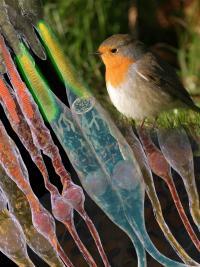
How do migratory birds, sometimes travelling thousands of miles from where they live, find their way back to the same place where they ride out each winter?
It's been an ongoing mystery for the ages, and researchers in the field of ornithology have been trying to zero in on specifically where this navigation system resides in their heads. Previously, it's been determined that it's found somewhere in the bird's eye, but now a team of European scientists believe that a particular protein in the retina, known as a cryptochrome, serves as a bird's center of navigation.
"We believe that we have strong evidence," said Associate Professor Ilia Solov'yov, a theoretical physicist at the University of Southern Denmark, "to pinpoint the right magnetoreceptor molecule in migratory birds."
In the study of European robins, these researchers focused on the group of four cryptochromes that have been identified in the retina of many species of birds. This group is believed to be a migratory bird's "magnetic compass," which is light dependent. Of the four, the researchers found that three of them did not take part in magnetoreception. But the remaining cryptochrome, known as Cry4, was found to be unique, containing "structural motifs that agree well with indirect measurements," Solov'yov adds, "and show clear differences to other cryptochromes from plants and insects."
"When light hits cryptochromes in the eye of a migrating bird, they undergo chemical reactions that are influenced by the direction of Earth's magnetic field, providing a signal of the bird's orientation," according to a statement released by the University of Southern Denmark.
The study, titled "Double-Cone Localization and Seasonal Expression Pattern Suggest a Role in Magnetoreception for European Robin Cryptochrome 4," was recently published in the journal Current Biology.
While the authors of the paper cannot say with certainty that Cry4 is responsible for a migratory bird's navigation, they believe their process of elimination indicates that it is.
"Even though there is no clear evidence showing which of the four cryptochromes—if any—is the primary magnetoreceptor in night-migratory songbirds, several properties of erCry4 indicate that it differs from other cryptochromes," the researchers state in their conclusion. "This makes Cry4, in our opinion, the most likely magnetoreceptor candidate among the cryptochromes."



